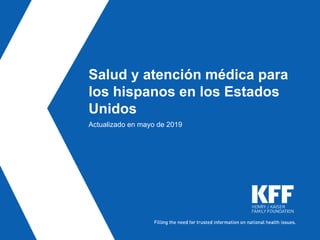
Salud y Atencion Medica para los Hispanos en Estados Unidos - May 2019
- 1. Salud y atención médica para los hispanos en los Estados Unidos Actualizado en mayo de 2019
- 2. Figure 1 2017: Cerca de 58 millones de personas son hispanas, esto es casi 1 de cada 5 personas. Los hispanos constituyen una parte importante y creciente de la población de los Estados Unidos. Source: Kaiser Family Foundation analysis of 2017 American Community Survey (ACS), 1-Year Estimates and U.S. Census Bureau 2017 National Population Projections Tables, https://www.census.gov/data/tables/2017/demo/popproj/2017-summary-tables.html. 2060: Se proyecta que más de 1 de cada 4 personas en los Estados Unidos sea hispana en 2060.
- 3. Figure 2 Los hispanos representan una mayor proporción de la población en el oeste. Source: Kaiser Family Foundation analysis of 2017 American Community Survey (ACS), 1-Year Estimates. PORCENTAJE DE LA POBLACIÓN TOTAL HISPANA POR ESTADO, 2017 5-15% (26 estados + DC) < 5% (12 estados) > 15% (12 estados) CA AK OR WA ID NV TX LA AROK KS MO WY MT ND SD MN WI MI IA NE CO UT AZ NM IL IN OH PA GA FL SC NC VA KY TN ALMS ME NY MA RI CT DE VT NH MD DC NJ
- 4. Figure 3 La mayoría de los hispanos son parte de familias con un trabajador, pero suelen se más pobres que los blancos no hispanos. También son más jóvenes y es más probable que no sean ciudadanos. * Indicates statistically significant difference from the White population at the p<0.05 level. Note: Persons of Hispanic origin may be of any race; Whites are non-Hispanic and exclude individuals of mixed race. Includes nonelderly individuals 0-64 years of age. Source: Kaiser Family Foundation analysis of 2017 American Community Survey (ACS), 1-Year Estimates. 84% 16%* 63%* 21%* 84% 8% 49% 2% Trabajador de tiempo completo en la familia Ingreso familiar por debajo del nivel de pobreza De 34 años y más jóvenes No ciudadanos Hispano Blanco No Hispano
- 5. Figure 4 Los hispanos enfrentan una serie de retos de salud. Note: Persons of Hispanic origin may be of any race; Whites are non-Hispanic and exclude individuals of mixed race. Includes nonelderly adults 18-64 years of age. All values have a statistically significant difference from the White population at the p<0.05 level. Source: Kaiser Family Foundation analysis of 2017 National Health Interview Survey (NHIS) and 2017 Behavioral Risk Factor Surveillance System (BRFSS). ESTADO DE SALUD Y CONDICIONES DE SALUD SELECCIONADAS ENTRE ADULTOS MENORES DE 65 AÑOS, 2017 11% 33% 9%9% 30% 7% Salud regular o malo Obesos El doctor les dijo que tienen diabetes Hispano Blanco No Hispano
- 6. Figure 5 Los hispanos son más de 3 veces más propensos a ser diagnosticados con VIH y tienen una tasa de embarazo adolescente más de 2 veces más alta que las blancas. Note: HIV diagnosis rates are for ages 13 and older. For birth rate, persons of Hispanic origin may be of any race; Whites are non- Hispanic. Source: Centers for Disease Control and Prevention, National Center for HIV/AIDS, Viral Hepatitis, STD, and TB Prevention (NCHHSTP) AtlasPlus; Martin JA, Hamilton BE, Osterman MJK, Driscoll AK, Drake P. Births: Final data for 2017. National Vital Statistics Reports; vol 67 no 8. Hyattsville, MD: National Center for Health Statistics. 2018. 21 29 6 13 Tasa de diagnosis de VIH entre los adolescentes y adultos, ajustado por edad (por cada 100,000) Tasa de embarazo para adolescentes entre 15 y 19 años (por cada 1,000) Hispano Blanco No Hispano
- 7. Figure 6 Entre los adultos menores de 65, los hispanos enfrentan barreras más grandes para acceder a la atención que los blancos no hispanos. Note: ^ Indicates in the past 12 months. Persons of Hispanic origin may be of any race; Whites are non-Hispanic and exclude individuals of mixed race. Includes nonelderly individuals 18-64 years of age. Data for uninsured includes nonelderly adults 19-64 years of age. All values have a statistically significant difference from the White population at the p<0.05 level. Source: Kaiser Family Foundation analysis of 2017 American Community Survey (ACS), 2017 National Health Interview Survey (NHIS), and 2017 Behavioral Risk Factor Surveillance System (BRFSS). 25% 22% 25% 25% 46% 8% 13% 14% 15% 32% Sin seguro Atrasan atención necesaria debido al costo^ Sin una fuente habitual de atención Sin una cita médica^ Sin una cita con el dentista^ Hispano Blanco No Hispano
- 8. Figure 7 Los hispanos son más propensos de tener otras características que afectan la salud. Note: Persons of Hispanic origin may be of any race; Whites are non-Hispanic and exclude individuals of mixed race. Source: U.S. Census Bureau, 2017 American Community Survey 1-Year Estimates (Language Other than English Spoken at Home and Education, both among nonelderly adults, ages 19-64), U.S. Department of Agriculture, Economic Research Services, Household Food Security in the United States in 2017, Child Trends, Neighborhood Safety, 2016. 75% 26% 18% 10% 6% 6% 9% 3% Se habla otra idioma en la casa que no es inglés Tienen menos acceso a educación secundaria Inseguridad alimentaria en el hogar Los padres informan que sus hijos viven en un vecindario inseguro Hispano Blanco No Hispano
- 9. Figure 8 40% 33% 28% 26% 25% 15% 12% 9% 8% 8% 2013 2014 2015 2016 2017 Tasa de Adultos Menores de 65 Sin Seguro, 2013-2017 La tasa de hispanos sin cobertura disminuyó bajo ACA, pero todavía tienden a estar menos asegurados que los blancos no hispanos. Note: Nonelderly adults are 19-64 years of age. Children are ages 0-18 years. Whites are non-Hispanic and exclude individuals of mixed race. All values have a statistically significant difference from the White population at the p<0.05 level. Source: Kaiser Family Foundation analysis of 2017 American Community Survey (ACS), 1-Year Estimates. 12% 10% 8% 8% 8% 6% 5% 4% 4% 4% 2013 2014 2015 2016 2017 Hispano Blanco No Hispano Tasa de Niños Sin Seguro, 2013-2017
